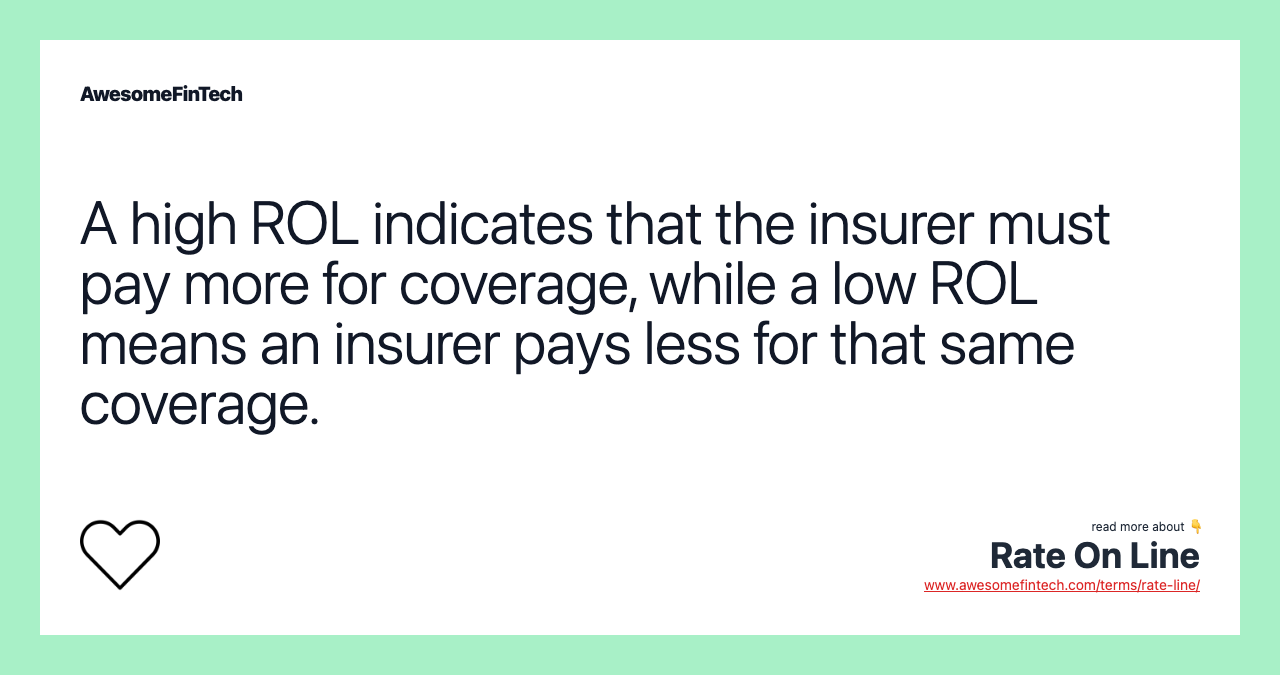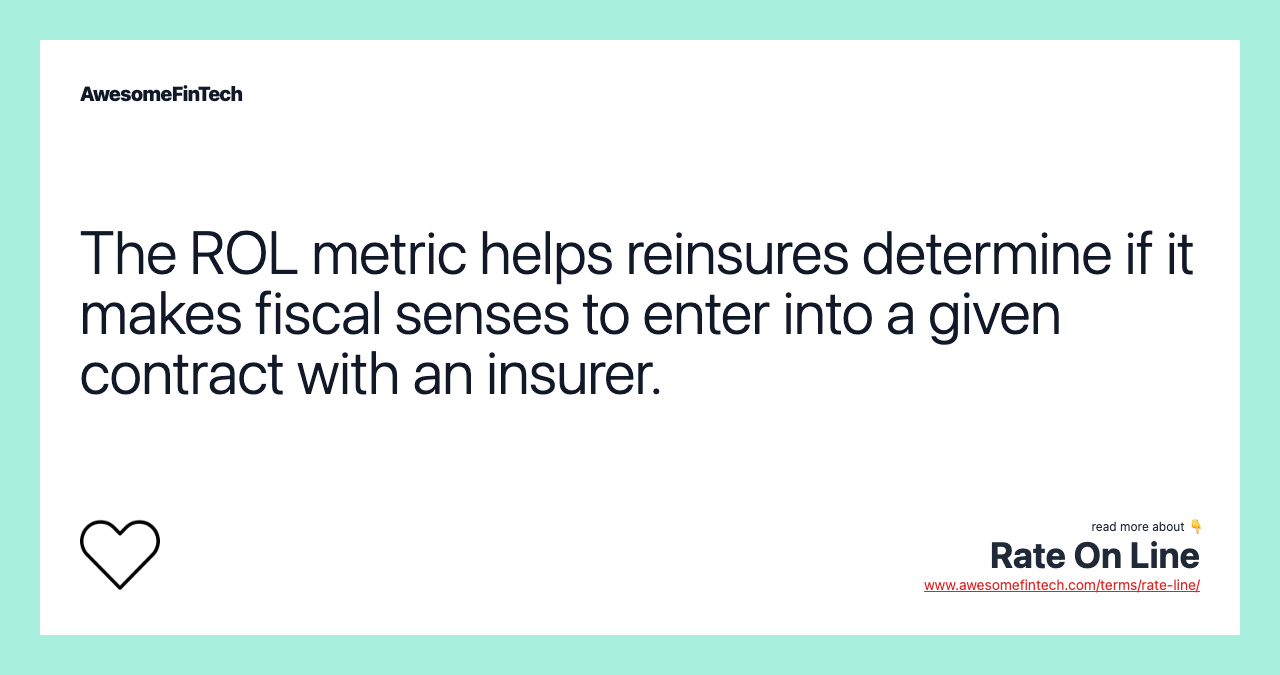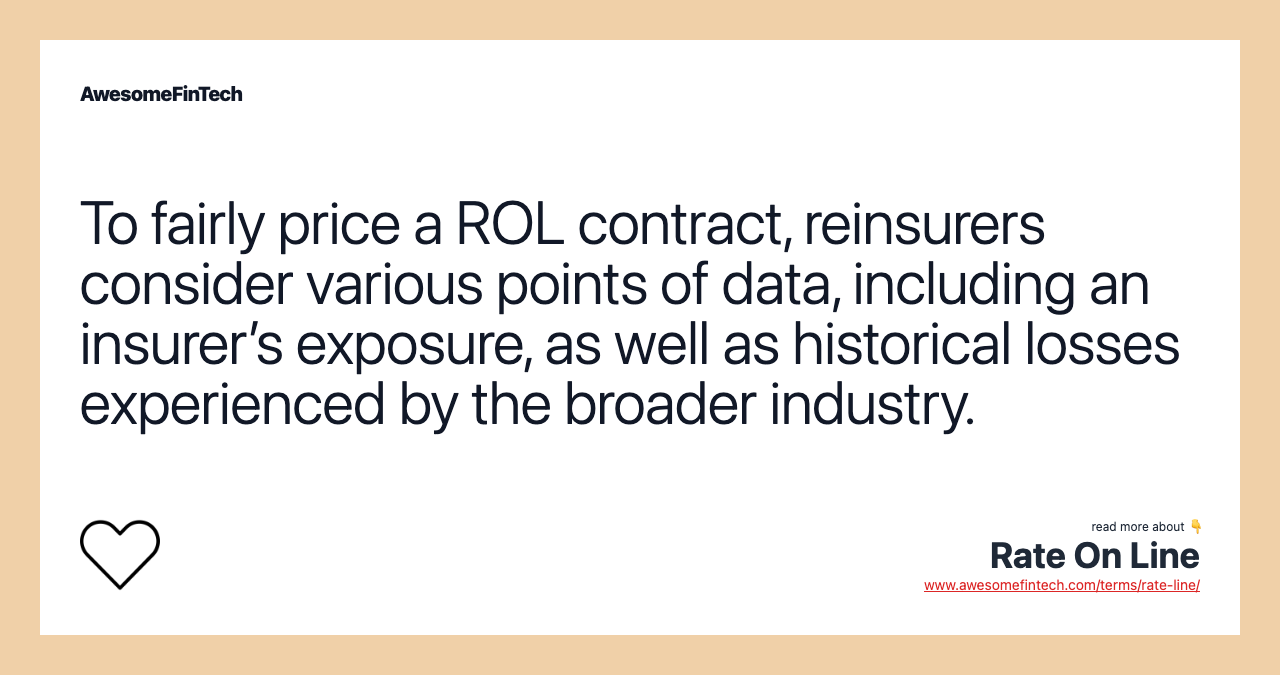Rate On Line
Rate on line (ROL) is the ratio of premium paid to loss recoverable in a reinsurance contract. A high ROL signals that the insurer must pay more for coverage, while a lower ROL means an insurer must pay less for that same level of coverage. Rate on line (ROL) is the ratio of premium paid to loss recoverable in reinsurance contracts, which signals how much money an insurer must pay to obtain reinsurance coverage. A high ROL indicates that the insurer must pay more for coverage, while a low ROL means an insurer pays less for that same coverage. To fairly price a ROL contract, reinsurers consider various points of data, including an insurer’s exposure, as well as historical losses experienced by the broader industry.

What Is Rate on Line?
Rate on line (ROL) is the ratio of premium paid to loss recoverable in a reinsurance contract. Simply put, ROL represents how much money an insurer must commit in order to obtain reinsurance coverage. A high ROL signals that the insurer must pay more for coverage, while a lower ROL means an insurer must pay less for that same level of coverage.




Understanding Rate on Line
Reinsurance lets insurance companies increase their capacity to underwrite new policies by transferring some of their liabilities to reinsurers. In exchange for doing this, the reinsurers receive a portion of the premiums insurers collect on those additional policies.
To price a reinsurance contract, a reinsurer must consider several factors, including the insurer’s exposures, as well as recent losses experienced by the industry at large. To accomplish this, reinsurers study market benchmarks, including the frequency and severity of claims made. If the number of reinsurers is limited and if recent historical losses have been substantial, insurers should expect to pay more for reinsurance coverage.
In such cases, insurers may adjust their underwriting activities by charging higher premiums or by altering the way they invest in premiums in order to maintain excess capacity.
The rate on line (ROL) is the inverse of the payback or amortization period.
Consider a property insurance company that seeks to shift some of its risk to a reinsurance company, in a concerted effort to mitigate its exposure to losses from potentially catastrophic flood activity. In this hypothetical scenario, both the reinsurer and insurer examine the severity and frequency of past claims and collectively decide on a contract in which the reinsurer will assume up to $20 million in liabilities.
In exchange, the insurer agrees to pay the reinsurer $4 million in premiums. Consequently, the rate on line for this contract is calculated by dividing the premium by the coverage, which comes to 20%. The payback period would be five years.
Rate on Line in Projecting Reinsurance Profitability
Rate on line helps reinsurers gauge the potential profitability of a proposed contract. But this analysis becomes complicated when reinstatement provisions, expenses, and carry-forward provisions from earlier years are taken into account.
Calculations become even more difficult when additional premium and profit commission percents change for each year or if coverage is canceled. Fortunately, using a frequency distribution can help insurers and reinsurers visualize this data because the mean of the distribution relates to the payback period for traditional risk covers. This payback period can be compared to the results of catastrophe models or other pricing analyses.
Related terms:
Accounting
Accounting is the process of recording, summarizing, analyzing, and reporting financial transactions of a business to oversight agencies, regulators, and the IRS. read more
Benchmark
A benchmark is a standard against which the performance of a security, mutual fund or investment manager can be measured. read more
Catastrophe Reinsurance
Catastrophe reinsurance protects catastrophe insurers from financial ruin in the event of a large-scale natural or human-made disaster. read more
What Is a Ceding Company?
A ceding company is an insurance company that passes a part or all of its risks from its insurance policy portfolio to a reinsurance firm. read more
Excess Limits Premium
Excess limits premium is the amount paid for coverage beyond the basic liability limits in an insurance contract. read more
Excess Capacity
Excess capacity occurs when a business produces less output than it actually could because there is not a demand for the product. read more
Frequency Distribution
Frequency distribution is a representation, either in a graphical or tabular format, that displays the number of observations within a given interval. read more
Gross Net Written Premium
Gross net written premium income is the amount of an insurance company’s premiums that are used to determine the amount of premiums owed to a reinsurer. read more
Life Insurance Guide to Policies and Companies
Life insurance is a contract in which an insurer, in exchange for a premium, guarantees payment to an insured’s beneficiaries when the insured dies. read more